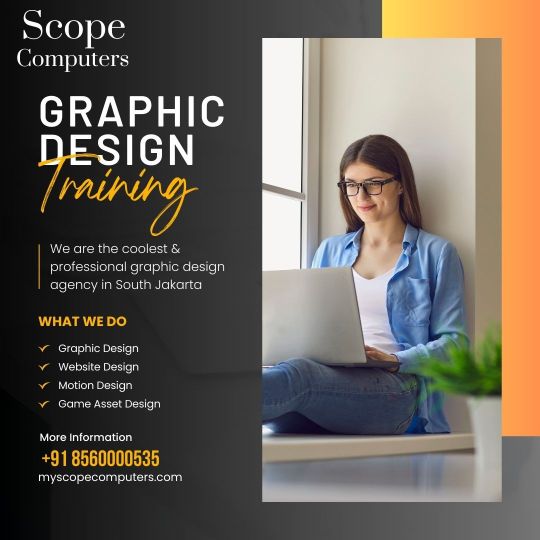#bestonlineclassesforgraphicdesign
Explore tagged Tumblr posts
Text
Scope Computers
Graphic Design
Visual Communication: Graphic design is primarily about visual communication. Designers use various elements like images, symbols, and text to convey messages or evoke specific emotions.
Typography: This involves selecting and arranging typefaces (fonts), font sizes, line lengths, and spacing to make written language legible and visually appealing. Typography plays a crucial role in the overall design aesthetic.
Color Theory: Understanding color psychology and how different colors interact is essential for effective graphic design. Colors can influence mood, convey meaning, and create visual hierarchy within a design.
Layout and Composition: The arrangement of visual elements on a page or screen is critical for readability and impact. Designers use principles such as balance, proximity, alignment, and contrast to create well-structured compositions.
Imagery and Iconography: Graphics often incorporate illustrations, photographs, icons, and other visual elements to enhance messaging. These visuals can be custom-created or sourced from existing libraries.
Software Skills: Graphic designers use various software tools like Adobe Illustrator, Photoshop, and InDesign to create and manipulate visual content. Proficiency in these tools is essential for executing design concepts.
Brand Identity and Logo Design: Graphic designers often work on creating or refreshing brand identities, which includes designing logos, color schemes, and visual assets that represent a company or organization.
Print vs. Digital Design: Graphic design can encompass both print and digital mediums. Print design involves creating materials like brochures, posters, and packaging, while digital design includes web graphics, social media assets, and interactive media.
User Experience (UX) Design: In digital graphic design, UX principles are crucial for ensuring that designs are not only visually appealing but also intuitive and functional for users.
Creative Process: Graphic design typically follows a creative process that includes brainstorming, conceptualization, iteration, and final execution. Designers often collaborate with clients or stakeholders to refine ideas and meet specific objectives.
Graphic design is a versatile field with applications in advertising, branding, publishing, web design, user interface (UI) design, and more. It requires a blend of artistic skill, technical proficiency, and creative problem-solving to produce compelling visual solutions.

#graphicdesigncourse#howtobecomeagraphicdesigner#bestgraphicdesign#bestgraphicdesigncoourseonline#computerdesigningcourse#graphicdesignfullcourse#graphicdesigntips#LearnGraphicDesign#coursesforgraphicdesignonline#howtobeagraphicdesigner#freeonlinegraphicdesigntraining#freedesignercourse#graphicartistcourseonline#graphicdesignclassesonline#graphicdesignclassesonlineforfree#graphicdesigncoursesnearme#graphicdesigncourseswithcertificates#graphicdesigntrainingonline#motiongraphicscourse#studygraphicdesignonline#3monthgraphicdesigncourse#animationandgraphicdesigncourses#basicgraphicdesigncourse#bestgraphicdesignclassesonline#bestgraphicdesigncoursesonlinefree#bestonlineclassesforgraphicdesign#bestonlinegraphicdesignclasses#bestonlinegraphicdesigncourseswithcertificates#canvagraphicdesigncourse#computercoursesgraphicdesign
0 notes